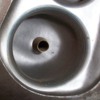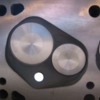They are nice now. If you remove the ring on the intake, that is considered a racing only modification.
The ring was originally cast into the intake on the Boss 302 iron head.
The 69 also used a 2.21 intake valve and switched to the 2.19 in 70.
That was an attempt to build more off idle torque in a street engine.
The iron 351c 4v head is a continuation of the thinking by Ford of the Boss 302 issues solving for STREET cars and engines.
What you do now all depends on what you are going to do with the engine?
Porting iron 4v heads is controversial. Many head porters will say leave them alone but what happens is the bottom cut of the valve seats, the angle can vary for differing results.
I personally think it should be completely blended into the port at around 90 degrees?
The Ford Boss 302 modification illustration from 1969 shows that in a cross section.
The problem with that is it wasn't the final race configuration of the head necessarily.
As far as removing completely the remainder of the iron cast in valve guide, consider that a support for the bronze guide. Don't go any further at this point in removing more of it.
My A3 Motorsport heads DO have that bottom cut as part of the port pocket with no indications of ever having had the ring.
If you CC that port it will be right around 238cc. It's a big port.
Others will tell you that the C302B head has a smaller port but flows as much with a smaller valve.
You probably would benefit from speaking to Dan Jones who has done dyno work on various combinations and could point you in the right direction.
He works with an experienced "Cleveland" engine builder with a bunch of flow bench/porting experience on these engines.
Those are two that you could seek their expertise on before you over port these heads?
You PROBABLY don't need to do much with the intakes now BUT the exhausts on the iron heads to race need radical porting and the roof needs to be raised.
Stock the exit angle is wrong.
This is where you see the race heads with the 1" aluminum plates installed to change the angle of the port upward.
When the aluminum Motorsport heads first appeared, Don Nicholson was asked about them.
Basically he was not impressed with them at the time. His comment was that he was getting over 800hp with the iron heads back in the day and that the Aluminum heads didn't.
So you will get all sorts of opinions on this subject and PROBALBY the thing to do is what new car manufacturers do, model your car after what the other guy did (who was successful), like Ferrari vs. Porsche, borrowing (stealing) only the best ideas of the other?

It is unclear to me IF the Detomaso race Panteras had that exhaust port modification on them or if it was even allowed under the rules then? I was told yes they did have the mod but I've never seen anything that would "corroborate" that statement?
So far the ports look good with the guides.
Do a search for Dan Jones posts on this forum. It will lead you to some of the information that you need and cross reference to other links as well.










